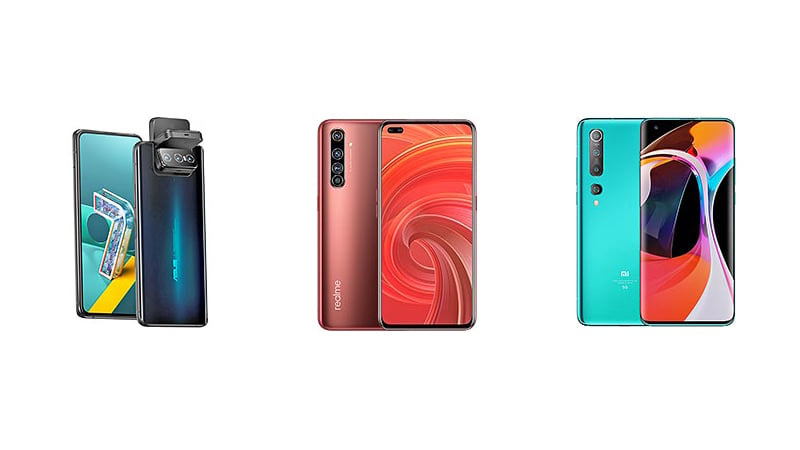Another 2020 flagship killer series went official and a lot of people are wondering whether or not it is the definitive flagship killer series. We are talking about the Asus Zenfone 7 line-up composed of the Zenfone 7 and the Zenfone 7 Pro. The former is a device with flagship-class hardware sold at an incredibly affordable price if compared to other flagships. It is mandatory for us to make a comparison between this device and other flagship killers in order to establish whether or not this is the device a lot of power users should get in this second half of 2020. So, we decided to compare it with the Xiaomi Mi 10 and the Realme X50 Pro, both affordable flagships, both with Snapdragon 865 just like the Asus Zenfone 7.
Asus Zenfone 7 vs Realme X50 Pro vs Xiaomi Mi 10
| Xiaomi Mi 10 | Asus Zenfone 7 | Realme X50 Pro 5G | |
|---|---|---|---|
| DIMENSIONS AND WEIGHT | 162.6 x 74.8 x 9 mm, 208 g | 165.1 x 77.3 x 9.6 mm, 230 g | 159 x 74.2 x 9.4 mm, 207 g |
| DISPLAY | 6.67 inches, 1080 x 2340p (Full HD+), Super AMOLED | 6.67 inches, 1080 x 2400p (Full HD+), Super AMOLED | 6.44 inches, 1080 x 2400p (Full HD+), Super AMOLED |
| PROCESSOR | Qualcomm Snapdragon 865, octa-core 2.84 GHz | Qualcomm Snapdragon 865, octa-core 2.84 GHz | Qualcomm Snapdragon 865, octa-core 2.84 GHz |
| MEMORY | 8 GB RAM, 128 GB – 8 GB RAM, 256 GB – 12 GB RAM, 512 GB | 6 GB RAM, 128 GB – 8 GB RAM, 128 GB – micro SD dedicated slot | 6 GB RAM, 128 GB – 8 GB RAM, 128 GB – 12 GB RAM, 256 GB |
| SOFTWARE | Android 10, MIUI | Android 10, Zen UI | Android 10, Realme UI |
| CONNECTIVITY | Wi-Fi 802.11 a/b/g/n/ac/ax, Bluetooth 5.1, GPS | Wi-Fi 802.11 a/b/g/n/ac/ax, Bluetooth 5.0, GPS | Wi-Fi 802.11 a/b/g/n/ac/ax, Bluetooth 5.1, GPS |
| CAMERA | Quad 108 + 13 + 2 + 2 MP, f/1.7 + f/2.4 + f/2.4 + f/2.4 20 MP f/2.0 front camera |
Triple 64 + 8 + 12 MP, f/1.8 + f/2.4 + f/2.2 | Quad 64 + 12 + 8 + 2 MP, f/1.8 + f/2.5 + f/2.3 + f/2.4 Dual 32 + 8 MP f/2.5 and f/2.2 front camera |
| BATTERY | 4780 mAh, fast charging 30W, Fast wireless charging 30W | 5000 mAh, fast charging 30W | 4200 mAh, fast charging 65W |
| ADDITIONAL FEATURES | Dual SIM slot, reverse wireless charging 10W, 5G | Dual SIM slot, 5G | Dual SIM slot, 5G |
Design
The most original design belongs to the Asus Zenfone 7 due to the presence of flip-up camera and a true full-screen display. But the most beautiful device is the Xiaomi Mi 10, in my honest opinion. Its curved edges and its high screen-to-body ratio are simply amazing and they make it look like one of the most expensive flagships out there. With Asus Zenfone 7 you get a sturdier front panel thanks to the Gorilla Glass 6 protection, but it has an inferior Gorilla Glass 3 for the glass back. Realme X50 Pro 5G is still made of premium materials, but I like the design of the Xiaomi Mi 10 more.
Display
The displays of these devices are more or less at the same level. In each case, you get a Full HD+ resolution, a 90 Hz refresh rate, and the HDR10+ standard. But the Asus Zenfone 7 looks slightly better due to its higher brightness. However, we had no chance to test the color accuracy and other display features of this device, so we can not give you a definitive verdict. Note that Xiaomi Mi 10 and Realme X50 Pro 5G feature an in-display fingerprint reader, while the Asus Zenfone 7 has a side-mounted biometric sensor. Last but not least, Xiaomi Mi 10 and Asus Zenfone 7 come with a wider diagonal.
Hardware/Software
The awesome Snapdragon 865 mobile platform powers all of these handsets: not the most advanced Qualcomm’s SoC out there, but it takes the silver medal right behind the Snapdragon 865+. Asus Zenfone 7 only gets 8 gigs of RAM in its most expensive configuration, while you can get up to 12 GB of RAM with Xiaomi Mi 10 and Realme X50 Pro 5G. On the other hand, Asus Zenfone 7 has UFS 3.1 storage instead of UFS 3.0, as well as a micro SD slot to expand its native storage (which is not present on Xiaomi Mi 10 and Realme X50 Pro 5G). All of the devices run Android 10 with a highly-customized user interface.
Camera
If we talk about the main sensor of the rear camera, Xiaomi Mi 10 is the winner. It sports an amazing 108 MP sensor just like the Mi 10 Pro, as well as OIS. But it lacks a telephoto lens, unlike Realme X50 Pro 5G and Asus Zenfone 7. Further, it has a pretty disappointing front camera. The Asus Zenfone 7 can use its rear triple camera as a selfie camera too, thanks to its motorized mechanism. The Realme X50 Pro 5G has a great dual front camera with 32 and 8 MP resolution, as well as an ultrawide sensor.
Battery
The Asus Zenfone 7 has the biggest battery and, with a 5000 mAh capacity, it is likely to last a lot more than Realme X50 Pro 5G and Xiaomi Mi 10. With the Realme X50 Pro 5G, you get the smallest battery, but also the fastest charging technology: 65W power instead of 30W found on the Asus Zenfone 7 and the Xiaomi Mi 10. On the other hand, Xiaomi Mi 10, which sits in the middle in terms of capacity, offers both fast wireless charging and reverse wireless charging.
Price
The price of Asus Zenfone 7 for the global market is yet to be announced (€600/$710 in Taiwan). You can get a Xiaomi Mi 10 for less than €600/$710 thanks to online street prices, and it is the same for the Realme X50 Pro 5G. It is very hard to pick a winner of this comparison. Asus Zenfone 7 has a better display, a bigger battery, and a flip-up camera. Xiaomi Mi 10 offers wireless charging, reverse wireless charging, and a better main camera. Realme X50 Pro 5G has great selfie cameras and faster charging. Which one would you pick?
- Read More: Xiaomi sold Mi 10 units worth 200 million yuan within a minute in its first sale in China
Asus Zenfone 7 vs Realme X50 Pro vs Xiaomi Mi 10: PRO and CONS
Realme X50 Pro 5G
PROS
- Fastest charging technology
- Dual ultrawide front cameras
- Good street prices
- Compact
CONS
- Smaller battery
Xiaomi Mi 10
PROS
- OIS
- Great design
- Reverse wireless charging
- Fast wireless charging
CONS
- No telephoto
Asus Zenfone 6
PROS
- Flip-up cameras
- Micro SD dedicated slot
- Bigger battery
- Gorilla Glass 6
CONS
- Slower charging







